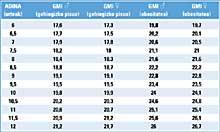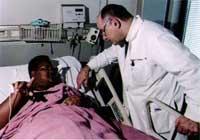Obesity: XXI. 20th century epidemic
2005/02/01 Orive Arroyo, Gorka - Farmazian doktorea. Biofarmazia, Farmakozinetika eta Farmazia-teknologiako irakasle kolaboratzaileaFarmazia Fakultatea UPV-EHU, Vitoria-Gasteiz Iturria: Elhuyar aldizkaria

The definition of obesity is entirely arbitrary, but according to experts, when overweight reaches 20-25% health risks begin. The most appropriate method for measuring the disease is body mass index (BMI). This index is calculated by dividing the weight of this person by the square of his height; if the result is a number of between 25 and 30 means overweight and if it is greater than 30 means obesity.
The causes of obesity can be diverse. On the one hand, it can have genetic origin. Approximately 400 genes participate in the regulation of body weight, mainly through peptides, hormones and monoamines that produce them. Moreover, nervous, endocrine and metabolic system behaviors play an important role in this disease. However, for a better understanding of all, the main cause of obesity is the imbalance between calories taken and lost. That is, we take more calories than necessary and burn less than necessary.
As a consequence of all of them, the disease appears and, together with it, other pathological alterations such as hypertension, cardiovascular risk, diabetes, stroke and an increased risk of suffering certain types of cancer. According to Spanish statistics, one in 12 deaths currently has a direct relationship with obesity. In addition, according to these data, 14.5% of adults are obese and 39% are overweight.
Childhood obesity

In recent years the problem of obesity has had a direct impact on another segment of society. In fact, according to the Spanish Ministry of Health, childhood obesity, especially between the ages of 6 and 12, is 16.1%, a point and a half above adults. This data places Spain second behind Britain in the ranking of European countries. In addition, since 1984 the percentage of obese children has tripled.
All experts have looked for the causes of this growth. They consider that changes in children's diet in recent years are related. We must bear in mind that our society unfortunately moves away from the Mediterranean diet, and that we increasingly take more cooked food, and more and more fast food.
Thus, our children have replaced the traditional sandwich and water with soft drinks. In addition, many children do not eat breakfast well, some do not eat breakfast and they do less and less sport. Therefore, childhood obesity has become a priority problem in our health system, since 80% of obese children will also be obese when they mature, suffering other alterations that accompany the disease and poor quality of life. Looking ahead, forecasts are not optimistic: if immediate action is not taken, by 2030 60% of the European population will be fat. And as for cost, the data are also representative. In Spain alone, obsiveness is an expenditure of 2.5 billion euros, 7% of total health expenditure.
Obesity control measures


The first measures to control obesity, both in children and adults, are related to food control. Reduce the consumption of animal fat and control the consumption of meat, egg, sugars and pastries. Olive oil, vegetables, cereals, pasta, fish, green beans and fruits must become the basis of our diet. And we must turn sport into a traditional practice. We should all incorporate some physical activity into our life, for example: walking 30 minutes after work, climbing stairs every day instead of taking the elevator, going to the mountain or to the beach on weekends, etc.
However, in some situations, especially in the most serious situations, all these measures do not yield positive results. In these cases other solutions must be sought. One of them is pharmacological treatments.
Some of the magic drinks that appear on television and in magazines are known to everyone, and with them 15 kilos are lost suddenly. In order not to deceive and solve the problem of obesity, quickly forget all these magical treatments and consult the doctor or endocrinologist, since all cases are different.
If we take any medicine, besides being safe, we must make sure it is effective. To be considered effective, the drug must avoid 5% of its weight compared to a placebo, in addition to maintaining this weight loss for a year.
Currently, the only medicines that have proven effective are orlistat and sibutramine. The first blocks the lipase enzyme from the area, causing a 30% reduction in fat absorption, while the second acts on the central nervous system giving the patient a feeling of satiety.

It also highlights the drug rimonabant in the third phase of clinical trials. This drug is an inhibitor of endocannabinoids receptors that regulate appetite and has been announced for marketing in 2006.
Operation
However, in severe cases surgery is needed to remove excess fat. However, only when the patient's BMI is greater than 40, doctors recommend surgery because surgery is dangerous. Proof of this are the 8 deaths that occurred in 2004.

Three types of interventions are performed to reduce stomach capacity. On the one hand, there is a restrictive technique that involves placing a flexible band around the stomach to reduce its capacity. There are derived techniques. In them a short circuit is made between the esophagus and the small intestine to reduce the trajectory of food in the digestive system. Finally, the most widely used mixed system. This technique involves reducing stomach contents by a by-pass. In any case, any surgical intervention will require careful selection of medical equipment and hospital to avoid negligence.
Obesity XXI. We can define it as an epidemic of the 20th century. The future adverse effects of this disturbance require immediate variant measures, especially to control the nutritional problems of today's children, of tomorrow's adults.

Gai honi buruzko eduki gehiago
Elhuyarrek garatutako teknologia






